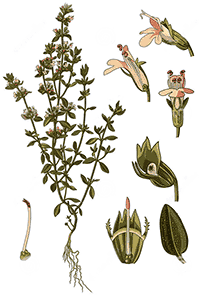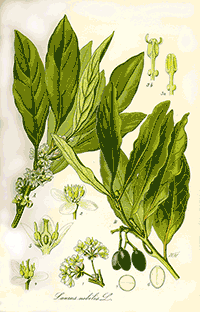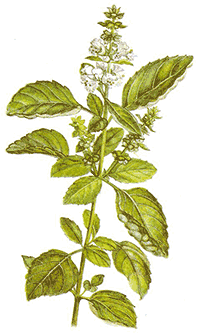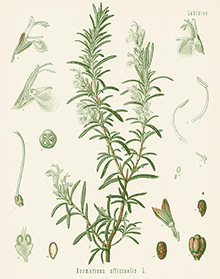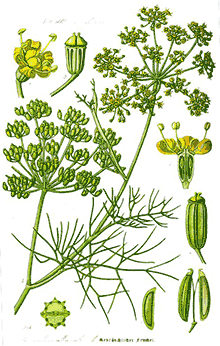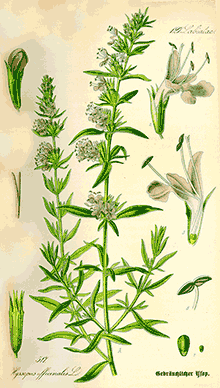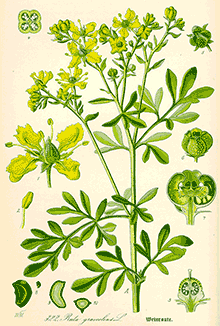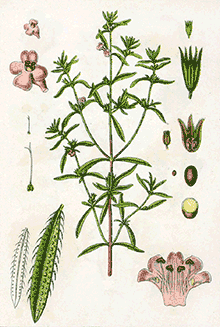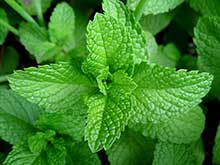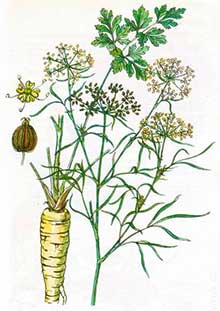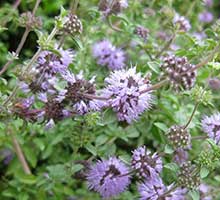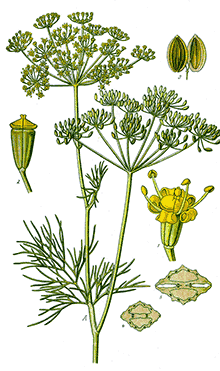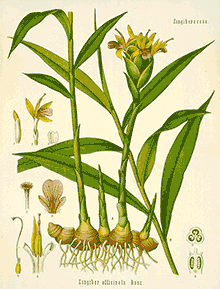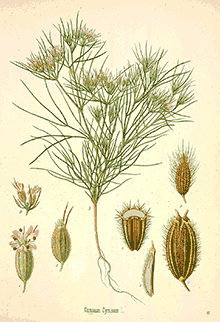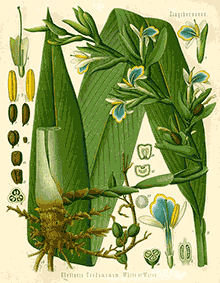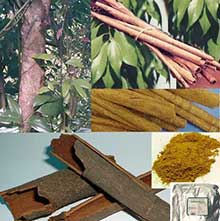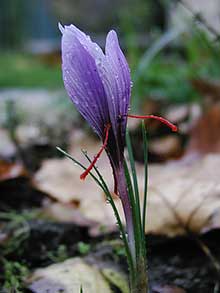Roman Cooking:
Herbs and Spices
The Romans were extravagant users of spices and herbs. Spice-flavored wines were used in ancient Rome and spice-scented balms and oils were popular for use after the bath. Since spices were considered to have health properties, they were also used in poultices and healing plasters. [Intro from the McCormick Science Institute History of Spices webpage]
Silphium
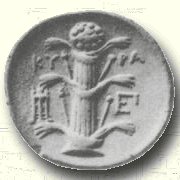 Silphium, was an herb much-prized by Roman cooks which came from the
former Greek colony of Cyrenaica, which was located in what is now the
Eastern coastal region of Libya. To make an ounce of Silphium last longer,
the cookbook of Apicius recommends keeping it in a jar of pine-nuts,
Silphium, was an herb much-prized by Roman cooks which came from the
former Greek colony of Cyrenaica, which was located in what is now the
Eastern coastal region of Libya. To make an ounce of Silphium last longer,
the cookbook of Apicius recommends keeping it in a jar of pine-nuts,
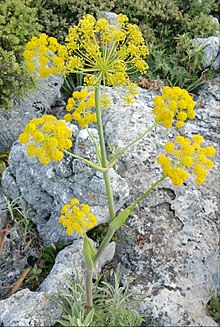 which would then absorb the flavour, much as a vanilla pod is used today
in a jar of sugar.
which would then absorb the flavour, much as a vanilla pod is used today
in a jar of sugar.
After the First Century A.D., Silphium seems to have become unobtainable and Pliny reported that the last known stalk of Silphium that was found in Cyrenaica, was given to the Emperor Nero "as a curiosity" — which he then, according to some accounts, promptly ate. After the decline of Silphium, substitute herbs such as Asafoetida were then often used in place of Silphium. Silphium was long considered extinct, but was thought to possibly be the Giant Tangier Fennel (Ferula tingitana), but that is not a universal belief and there is much to disprove this notion (not the least of which the plant doesn't really look like the ancient depictions)... You'll probably have to just do like they did and use Asafoetida. FLASH: read new note below on a serious possible find of Silphium in Anatolia.
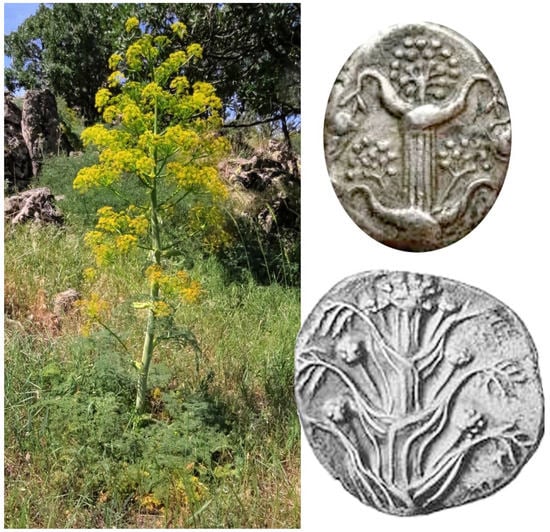 Silphium news!! Recently, a rare and endemic Ferula
species that produces a pleasant-smelling gum-resin was found in three
locations near formerly Greek villages in Anatolia. Morphologic features of
this species closely resemble Silphium (modern term:
"silphion"), as it appears in the numismatic figures of
antique Cyrenaic coins, and conform to descriptions by ancient authors. Initial chemical and
pharmacological investigations of this species have confirmed the medicinal
and spice-like quality of its gum-resin supporting a connection with the
long-lost silphion. A preliminary conservation study has been initiated at
the growth site of this rare endemic Ferula species. The results of this
study and their implications on the regional extinction event, and future
development of this species will be discussed. For more information on this
find, go here:
Silphium Paper and you
will find an academic document about it with tons of academic info. Sure
looks good.
Silphium news!! Recently, a rare and endemic Ferula
species that produces a pleasant-smelling gum-resin was found in three
locations near formerly Greek villages in Anatolia. Morphologic features of
this species closely resemble Silphium (modern term:
"silphion"), as it appears in the numismatic figures of
antique Cyrenaic coins, and conform to descriptions by ancient authors. Initial chemical and
pharmacological investigations of this species have confirmed the medicinal
and spice-like quality of its gum-resin supporting a connection with the
long-lost silphion. A preliminary conservation study has been initiated at
the growth site of this rare endemic Ferula species. The results of this
study and their implications on the regional extinction event, and future
development of this species will be discussed. For more information on this
find, go here:
Silphium Paper and you
will find an academic document about it with tons of academic info. Sure
looks good.
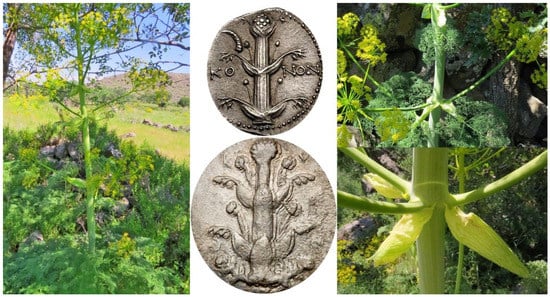
Opposite arrangement of the inflorescence branches and leaves/sheaths of Ferula drudeana.
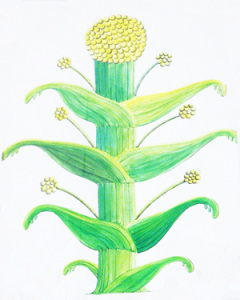 Other herbs often mentioned in Roman recipes include:
Other herbs often mentioned in Roman recipes include:
- Thyme
- Bay Leaf
- Rosemary
- Basil
- Fennel
- Hyssop
- Rue
- Savoury
- Mint
- Parsley
- Pennyroyal
- Dill
While spices such as Ginger, Cumin, Cardamon, Cinnamon and Saffron flavoured their many sauces.
Some Commonly-Used Roman Herbs
All of the spice and herb photos are now proper thumbnails — just click to see a larger image.
All of the spice and herb photos are now proper thumbnails — just click to see a larger image.
Why Romans liked their food so heavily spiced
One theory about the Romans and their preference for highly-flavoured foods, is that lead poisoning was prevalent among the aristocracy. This poisoning was due mainly to the use of lead-lined pots, for boiling a preservative syrup required by wine merchants. As the symptoms of lead poisoning include a metallic taste in the mouth and loss of appetite, it would follow that a chronic sufferer would seek to both kill this unpleasant taste and stimulate his jaded appetite.
The elder Cato, Columella, and Pliny all describe how unfermented grape juice (mustum, must) was boiled to concentrate its natural sugars:
"A product of art, not of nature the must was reduced to one half (defrutum) or even one third its volume (sapa)" (Pliny, XIV.80)
although the terms are not always consistent. Columella identifies defrutum as
"must of the sweetest possible flavour" that has been boiled down to a third of its volume (XXI.1).
Isidore of Seville, writing in the seventh century AD, says that it is sapa that has been reduced by a third but goes on to imagine that defrutum is so-called because it has been cheated or defrauded (defrudare) (Etymologies, XX.3.15). Varro reverses Pliny's proportions altogether (quoted in Nonius Marcellus, De Conpendiosa Doctrina, XVIII.551M).
The thickened syrup was used to sweeten and preserve wine and fruit that otherwise was sour or would spoil. Cato recommends that quinces and pears be preserved in boiled must (On Agriculture, VII.3) as does Varro (On Agriculture, I.59.3). Columella insists that defrutum always be boiled with quinces or some other flavoring (XII.20.2). Apicius offers directions for preserving quinces in defrutum and honey (De Re Coquinaria, I.21) and added the rich syrup to almost a fifth of his sauces to enhance the color and flavor of almost every dish. (That color was added indicates that red, rather than white, wine was used in the reduction.)
In De Agri Cultura, the earliest example of Latin prose (c.160 BC), Cato gives directions for reducing must in
"a copper or lead vessel" over a slow fire, "stirring constantly to prevent scorching; continue the boiling, until you have boiled off a half" (CVII)
Writing in the first century AD, Columella elaborates on the process.
"Some people put the must in leaden vessels and by boiling reduce it by a quarter, others by a third. There is no doubt that anyone who boiled it down to one-half would be likely to make a better thick form of must and therefore more profitable for use....But, before the must is poured into the boiling-vessels, it will be well that those which are made of lead should be coated inside with good oil and be well-rubbed, and that then the must should be put in....The vessels themselves in which the thickened and boiled-down must is boiled should be of lead rather than of brass; for, in the boiling, brazen vessels throw off copper rust, and spoil the flavour of the preservative" (XII.19.1, 19.6, 20.1)
People with very severe lead poisoning tend to have major neurological changes — brain swelling leading to seizures and headaches, aggressive behavior, loss of short-term memory, and slurred speech — and a host of other problems, like anemia and constipation.
Anyway, it's a theory... Try the spices yourself, but perhaps don't use the lead-lined vessels.
Even at the End
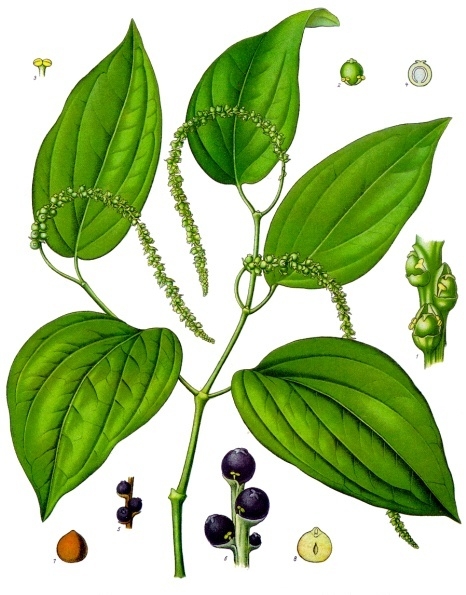 The Romans gobbled pepper up, and in Apicius’
Cooking and Dining in Imperial Rome, 80% of the recipes contain the spice. Nonetheless, not everybody was a
big fan, including Pliny the Elder:
The Romans gobbled pepper up, and in Apicius’
Cooking and Dining in Imperial Rome, 80% of the recipes contain the spice. Nonetheless, not everybody was a
big fan, including Pliny the Elder:
Whereas pepper has nothing in it that can plead as a recommendation to either fruit or berry, its only desirable quality being a certain pungency; and yet it is for this that we import it all the way from India!
The final collapse of the Roman Empire had a strange connection with one of the most highly prized spices of the time. When Rome was attacked in 410 AD, to lift the siege of the Visogoths and prevent the city from being sacked, along with gold, silver, silk, and hides, the Romans paid “three thousand pounds of pepper.” Negotiations soon broke down again, however, and the siege was resumed. Eventually though, the Eternal City was sacked.











